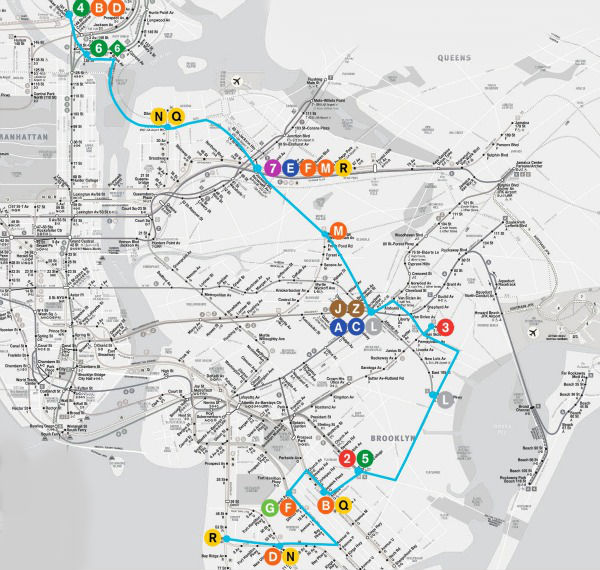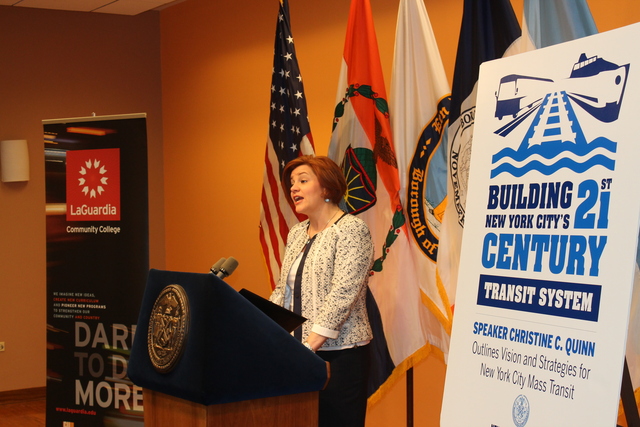Adding transportation options to help reduce travel time has become part of the agenda of mayoral hopeful City Council Speaker Christine Quinn. Recently, Quinn announced a two-pronged effort to provide more direct train and bus service from the Bronx to surrounding boroughs as part of her ten-year plan to reduce commuting time to less than one hour throughout New York City.
According to Quinn, New York’s transportation choices are in dire need of a serious revamping: “Our subway system was completed in the 1950s, when more than half of New Yorkers lived in Manhattan and less than 200,000 lived in Queens. Times have changed.”
To address congested transit lines, slow service, and the limited between-borough mobility for many commuters, especially those living in the Bronx, the first part of Quinn’s proposal involves launching a bus rapid transit line that will eclipse miles of circuitous roadways by providing direct service from the Bronx through Brooklyn and Queens. It would also supplement the existing Select Bus Services’ inefficiency.
Instead, Bus Rapid Transit would provide space for protected bus lanes, a design that has greatly increased transit efficiency in other cities, among them Bogotá, Columbia, which uses the Transmilenio bus service. Quinn hopes that protected lanes for buses would afford them the near efficiency of subway cars. [See a brief City Atlas interview about street space, with the former Mayor of Bogotá, Enrique Peñalosa.]
Quinn’s proposal is indeed ambitious; she intends to provide ten additional Select Bus Service routes in only four years. Beyond that, her proposal represents a viable alternative to the costly Triboro RX plan, also known simply as the X line. Proposed by the Regional Plan Association back in the 1996, the X line would be constructed along pre-existing railroad lines between the Bronx, Queens and Brooklyn. Though the X line was hailed for its potential to provide service to more than 76,000 commuters, the project wields a hefty price tag–$1 billion. Quinn’s Select Bus Service is estimated to cost $25 million dollars and will take less time to implement.

Triboro Bus Service, Quinn Campaign
As the second part of her transportation discussion, Quinn has called on the MTA to expand Metro North service in the East Bronx. Currently, only the 6 train line and the express bus provide service to the East Bronx. The expansion, Quinn says, will allow commuters the opportunity to “sit and have breakfast instead of grabbing a coffee to go… 20 minutes doesn’t sound like much, but it adds up to an extra three and half days each year.”
Her proposal envisions adding Metro North stops at Co-Op City, Morris Park, Parkchester, and Hunts Point. As part of the expanded service, Quinn imagines community reinvestment as a natural outcome, arguing that expanded service will attract business and create more jobs in the neighborhood.
Her plan may indeed help reduce travel time and bring transportation to underserviced areas, but what of other transportation options like bike shares? In her recent speeches, Quinn has made little mention of more eco-friendly alternatives, like adding more bike lanes or implementing congestion pricing throughout the city. While Quinn has supported congestion pricing in the past, her current proposal seems to be a more moderate version of the Bloomberg administration’s push towards making bike shares a major part of New York City’s transportation fabric.
In terms of carbon output, advocating for mass transit is a big step up from using personal vehicles in the city, but leaving zero-carbon surface vehicles like bikes out of the picture is definitely a step down environmentally. Within or without this proposed plan, how can New Yorkers keep pushing and moving in the right direction with transportation? Of the many tasks facing the next mayor, keeping the focus on newer and better transit initiatives, reaching all the boroughs, should be at the top of the list.
Photos: Dnainfo.com, This is How New York Works Capital
